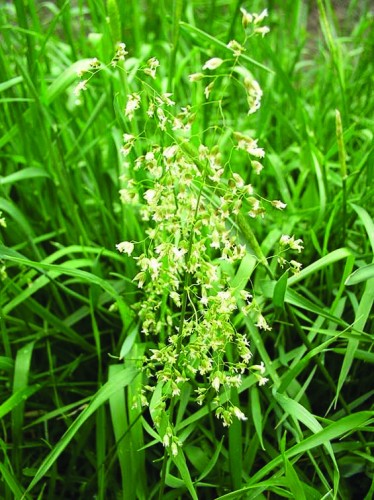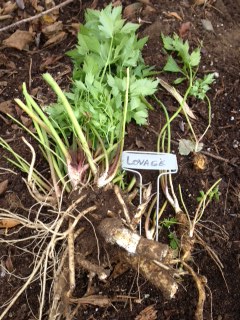by Kenan White | Apr 17, 2013 | Containers |
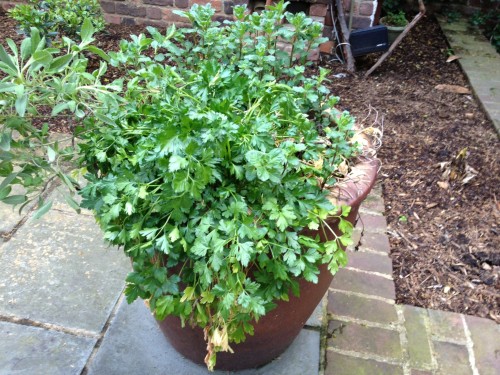
I’d like to take this opportunity, as many people throughout the country still await warmer weather before they can really start digging into the earth, to discuss my experience with container grown herbs . . .up close and personal.
It’s is so easy to plant a potted herb garden that many actually prefer to do so, instead of trying to find space amongst the vegetables. Plus, this makes it easier to place the garden right outside the kitchen, which also makes the home cook happy.
In order to make your own potted herb garden, use pots that are at least six inches in circumference, potting soil, compost, and a trowel. While some like to do smaller, individual pots, I like a larger potted garden, where plants can mingle. I recommend a large container. Mine is almost thirty inches in diameter, three-and-a-half feet tall, and sits tight against the house where it is well insulated.
Once you plant the first crop, it will be easier to maintain. I have had one outside for the past 3 years, and I only need to fill in a few plants each year. In my area, we are considered Zone 7. Herbs such as Garden Sage, Italian Parsley, Kitchen Citrus Mint, and Marjoram do very well in this zone and will all survive year after year, if properly cared for. However, there are always those I have to replace each spring. For instance, I need to replace my basil almost every year, and my thyme died this past winter.
As with any garden, there are a few persistent plants that will be more aggressive when fighting for space in the pot. You will have to be brutal with the mint, as it will take over the space if you let it. However, these hardier herbs are also survivors, and I am using parsley almost all year… and, of course, the mint. That’s not such a bad thing as I have discovered the value of minted water (I have a Brita and just keep a sprig or 2 in the bottom to flavor the water).
With your own potted herb garden, similar inspirations will only be a few steps away!
by Kenan White | Jan 24, 2013 | Gardening, Growing, Herbs, Life on the Farm, Seeds |
The Delta-T heating system we purchased will deliver heat where it matters most to plant development, the root zone. Everyone knows that a healthy plant must have a healthy root system. To insure all Growers Exchange herb plants fill their pot with vigorous roots, we will keep soil temperatures at 65 degrees to stimulate rapid root development.
To keep the green plant tops from growing too quickly, the air temperature in the greenhouse will be at 50 degrees at night. Growth is slower at cooler temperatures so the stems are thicker and stronger. The stem length between nodes is shortened, creating a symmetrical plant.
Bottom heat will also allow us to propagate more plants from cuttings. Many herbs like rosemary, lavender, and mint are best increased by vegetative propagation, also known as cloning. A mist system keeps the non-rooted plant stems hydrated until the warm soil promotes root growth. In about a month a new plant is ready to be re-potted.
Tropical herb plants like Lemon Verbena, Lemon Grass, Vietnamese Coriander, Dill, and Basil will also benefit from the new bottom heat. Try as we do, some days we can only keep the greenhouse but so warm. Wood fired space heaters warm the greenhouse air; but some winter days only so much heat is possible. We could also consider stone flooring that promotes underfloor heating and is able to retain heat well, allowing the plants to stay warm even when it’s cold outside. The bottom heat system, however, will act as a great attachment to the other options ensuring that our plants stay in their optimal temperature zones. Now we will be able to keep the root zone of these tropical herbs at their desired 65 degrees no matter what is happening outside.
As greenhouse growers, this new bottom heat is as exciting as Christmas! We will have plenty of herb plants ready for spring planting. The bottom heat helps the seedlings prepare for Spring. Winter is the best time to plan your herb garden. Don’t forget to order early, many herb plants are grown in limited quantity. And a tip from a greenhouse grower: have plants sent as early as your planting zone allows.
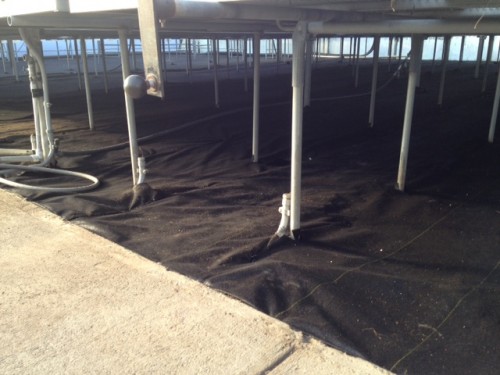
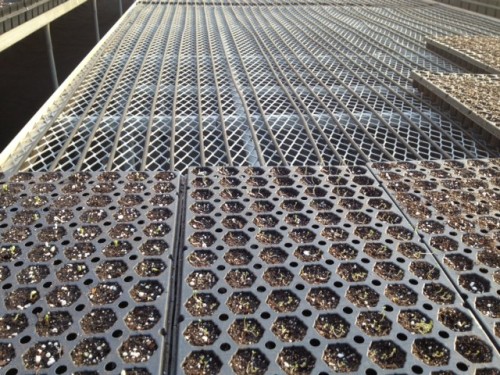
by Kenan White | Jan 17, 2013 | Basics, Gardening, Growing, Herbs, Seeds |
The Growers Exchange greenhouse staff is busy starting all the herb plants needed for our customer’s gardens this spring. Different plants are started by 3 different methods. Annual, biennial, and some perennial are easy to grow from seed. Basil, cilantro, arugala are examples of some herbs that grow quickly from seed. Italian parsley is slow, up to 3 weeks to germinate and another 4 weeks to grow to transplant size. This herb takes a long time grow from a seed, but there is no other way to obtain new plants. Anise Hyssop, Catnip, and Bergamot are examples of perennial herb plants that may take several weeks to germinate, but are still considered easy to grow from seed. A germination chamber is used to force seeds to sprout before their designated time; parsley goes from 21 to 5 days in the chamber. Seed flats must be taken out immediately after germination, as seedlings quickly die in the high humidity. Technically germination begins with the emergence of the radical. This is the first little white shoot tip to penetrate the seed shell, then germination is over and seedling growth begins. It doesn’t sound like much, if you think about it; emergence of the radical is one of the magic moments in nature. No one can fully explain or replicate a hard little thing that turns into a plant when water is added. Sowing seeds does leave the mind time to wander. And wonder!
Herbs that grow as a shrub, such as rosemary, lavender, and germander could be grown from seed, but would not produce a transplant for 1 or 2 years. To avoid the long seedling stage, Stem cuttings are kept under mist and have a heat source below keeping the root zone warm. The stems soon grow roots and a miniature version of the parent plant is soon ready to transplant. Other herbs such as Costmary defy these methods. Bible leaf plants grow from a rhizome which is divided into new plants by cutting a piece of root with a leaf bud. These divisions also grow a clone of the parent plant.
All these herb plants are on a schedule with someone’s garden. We time our plants to be ready for their new home early this spring.

by Kenan White | Jan 9, 2013 | Basics, Gardening, Growing, Herbs |
We get many calls from people concerned about the foliage of their herb plants. Each herb is different as has different growing requirements and characteristics. Overall, it is safe to say almost all herb plants prefer full sun all day long as well drained soil. Meeting these two basic requirements will eliminate most problems growing herb plants.
The amount of sun needed for growth cannot be met in a window during winter months. The declining number of daylight each day signals that it is time for the plant to go dormant. Each plant has its own type of dormancy. Some die back to the ground and have no green showing at all until spring.
Lemon Balm, mints, and lovage are examples of herb plants that die to the ground in winter. Shrubby plants like rosemary, lavender, sage and thymes are green in winter, but growth is stopped until spring. Leafy plants such as parsley and cutting celery must be grown large enough before fall to sustain winter cutting. Keeping herbs in a sunny window in winter keeps them close by for cutting as needed; make sure to have enough plants to last until spring.
Watering herb plants is simple. Water your herbs as little as possible. Wet soil will cause root rotting fungus to grow; never let herb plants stand in a saucer of water; water logging will drown the roots. When the soil is dry all the way to the bottom; water sparingly – just enough to dampen the soil.
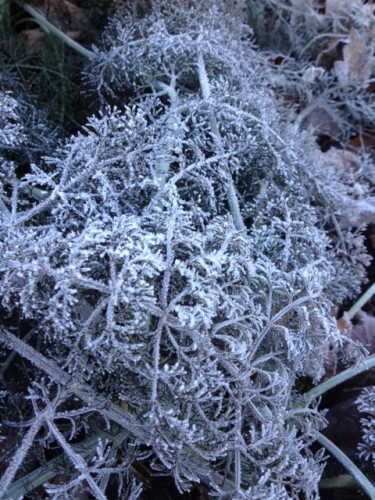
by Kenan White | Nov 12, 2012 | A Year in the Life.., Gardening, Life on the Farm |
The Growers Exchange herb garden is under going it’s fall make over. Most of the annuals have been removed: several frosts left basil looking limp. Fall is the best time to move and divide perennials. Having substituted all the flowering plants with herb plants, we must study their garden characteristics just as with plants grown strictly for flowers.
The border along our office wall needed a new screening plant at the back of the bed. We were looking for a tall green plant to high light the shorter herbs growing in front. We could have easily chosen fennel in green or bronze to block the white wall, but they are already being used are center specimens in island beds. Lovage is another plant with potential for screening.
The lovage in the photo was dug from another place in the garden. Along with the main clump, we divided off four smaller plants. These will be set out to catch up with the parent. If needed, the main clump could have been divided again into four or five smaller plants. In this case we wanted one large plant. If you have a lovage plant that requires moving or dividing, fall is the best time. The plant will establish roots until the ground freezes; this will produce a larger plant the following spring. To promote root growth an organic fertilizer should be applied.
by Kenan White | Nov 5, 2012 | Basics, Gardening, Growing, Herbs, Seeds |
Sweet grass (Hierochloe odorata) is a Native American grass used in prayer and purifying ceremonies. It is one of the four herbs sacred to Native Americans. Growing Sweet Grass is not difficult once you have a plant, but obtaining that first plant can be difficult. The seed does not store well, or maybe not at all. Purchased seeds come many times with a guarantee of only ten percent germination. From my experience purchasing Sweet grass seed, zero germination is more accurate.
If you have a Sweet Grass plant that is thriving, there are two ways to increase your number of plants. The easiest way is to sow fresh seeds harvested from your plant. I keep an open flat of potting soil next to potted sweet grass. As seeds mature and turn brown, I gently cut the stalk and then strip it of seeds over the soil. Spread the seeds evenly over the surface and gently water. Sometimes the stem holding the seed is still green, but make sure the seeds are completely brown before harvesting. Germination will begin in one to two weeks; allow the seedlings to grow a few inches before transplanting to pots. The seeds ripen over time, so you may have to leave the flat with the plants and harvest ripe seeds as they mature.
Division is the next best way to obtain more sweet grass plants. This is best done in fall or winter to plants that are dormant. Sweet grass spreads in clumps with rhizomes. These shoots can be separated from the mother plant once they have formed new roots. To protect the mother plant, remove side shoots and leave the main clump together. This method can only produce a few new plants at a time and requires some plant skills The fresh seeds of Sweet Grass germinate readily and the plants produce plenty of seed, so this is the easiest method to increase Sweet Grass.
